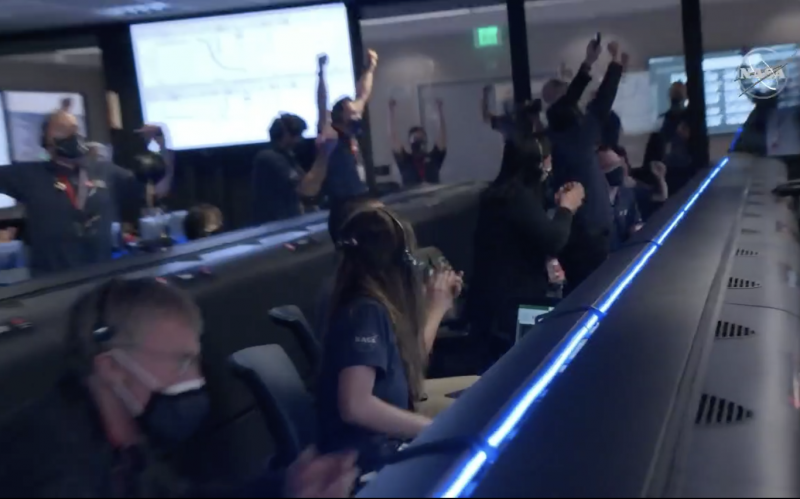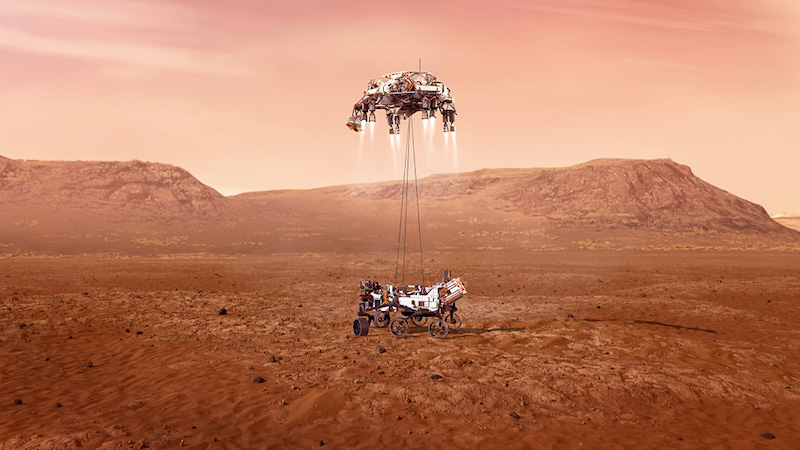
Click here for a cool video showing Perseverance’s descent and landing
On February 18, 2021, the Perseverance rover – formerly called Mars 2020 – became the first artificial object to land on Mars since the Insight Mars lander in 2018. It was the first rover to land since Curiosity touched down in 2012. Perseverance is the largest, most advanced rover NASA has sent to another world. It traveled 293 million miles (472 million km) – over 203 days – to get to Mars. Confirmation of the successful touchdown was announced at mission control at NASA’s Jet Propulsion Laboratory in southern California. Perseverance set down in Jezero Crater, just north of Mars’ equator. The first raw images have started coming in …
Landing on Mars is hard. Space engineers refer to it as seven minutes of terror. But the rover hit the Martian atmosphere traveling at almost 12,000 miles per hour (19,000 kmh), streaking across the sky as its protective heat shield helped to slow it down. Then, at an altitude of about 1 mile (1.5 km), the descent module fired its engines, while a new terrain relative navigation system kicked in to identify a safe landing spot. Essentially, it scanned and analyzed the terrain below, then matched it up with maps in its database to prepare for touchdown. A 70-foot (21-meter) diameter parachute deployed to slow the craft further, bringing its descent to a crawl. Finally, the hovering-landing sky crane system began its task of lowering the rover the rest of the way to the ground for a soft, gentle landing. Touchdown!
At the Jet Propulsion Laboratory, coronavirus protocols are still in effect at mission control, but not even a pandemic could dampen the celebration. Perseverance deputy project manager Matt Wallace said:
I don’t think that Covid is going to be able to stop us from jumping up and down and fist bumping. You’re going to see a lot of happy people no matter what, once we get this thing on the surface safely.

I’m safe on Mars. Perseverance will get you anywhere.
— NASA’s Perseverance Mars Rover (@NASAPersevere) February 18, 2021
Hello, world. My first look at my forever home. #CountdownToMars pic.twitter.com/dkM9jE9I6X
— NASA’s Perseverance Mars Rover (@NASAPersevere) February 18, 2021
And another look behind me. Welcome to Jezero Crater. #CountdownToMars pic.twitter.com/dbU3dhm6VZ
— NASA’s Perseverance Mars Rover (@NASAPersevere) February 18, 2021
Perseverance’s flashy new cameras are expected to have captured much of the landing process. A camera mounted on the back shell of the spacecraft is pointed upward. It recorded a view of the parachutes deploying as it slowed to land. Then, beneath it is a downward-pointing camera on the descent stage, which is supposed to have filmed its first touch-contact with the ground on Mars. This suite of technology will provide us with the most detailed video and photo records of landing on a neighboring world yet. Lori Glaze, who heads the Planetary Science Division of NASA’s Science Mission Directorate, told reporters:
We’re going to be able to watch ourselves land for the first time on another planet.
There wasn’t, however, a livestream of the footage, as we’re accustomed to with International Space Station events and rocket launches from Earth. The reason for this is a lag in data relay from Mars to Earth, which is slower than even old dial-up connections. Editor’s Note: the video is now available. See it here.
We’re also still waiting for a glimpse of Perseverance on the ground using the Mars Reconnaissance Orbiter, which can share at least low-resolution images with us in the coming days.
The 2021 lunar calendars are here. A few left. Order yours before they’re gone!
Design-wise, the Perseverance rover is very similar to the Curiosity rover, currently in Gale Crater, but has some different science instruments. While Curiosity focuses on finding evidence of past habitability, which it has done, Perseverance will be looking for direct evidence of life itself. This will be the first mission since the Viking 1 and 2 landers in the late 1970s/early 1980s to do so.
NASA chose Jezero Crater as the landing site for the Perseverance rover with good reason. Scientists believe the area was once flooded and home to an ancient water river delta more than 3.5 billion years ago. River channels spilled over the crater wall and created a lake, carrying clay minerals from its surroundings. Microbial life could have lived in the crater during one or more of these wet periods, and if so, signs of their remains might be found in lakebed or shoreline sediments. Scientists will study how the region formed and evolved, seek signs of past life, and collect samples of Mars rock and soil that might preserve these signs. The process of landing site selection involved mission team members and scientists from around the world, who carefully examined more than 60 candidate locations. But after the exhaustive five-year study of potential sites, each with its own unique characteristics and appeal, Jezero rose to the top.
In other words, the mission has really just begun. When asked if members of the engineering team will be able to revel in the excitement, biological sciences deputy lead Brian Shirey told EarthSky:
I’ve been working on the sample return mission … so it’s back to work later today!
To date, there’ve been only eight previous successful Mars landings: Viking 1 and Viking 2 (both 1976), Pathfinder (1997), Spirit and Opportunity (both 2004), Phoenix (2008), Curiosity (2012) and InSight (2018). The Soviet Union is the only other country to land spacecraft on Mars successfully. That was in 1971 and 1973.
On the other hand, once they get there, Mars missions may last for years, and robot rovers from Earth have spent years rolling around Mars. With the Perseverance mission, for the first time ever, NASA will try something new; it’ll release a small helicopter into the thin Martian air. The helicopter is called Ingenuity, which will attempt to scout around the small planet, trying to target locations of interest for future Mars missions.
In celebration of Perseverance’s landing, NASA is offering landing resources, ways to participate, social opportunities, and more. Download posters, stickers, fact sheets, mission patches, and more. Get lessons and activities for students, or even stamps for virtual passports, all available via their website here.

Bottom line: NASA’s Perseverance rover landed on Mars today, February 18. It carries science instruments to collect soil samples and look for signs of ancient life. It used audiovisual technology which will let us see and hear what it’s like to touch down on another world for the first time ever.
Read more from CNET: NASA Mars Perseverance rover: What to expect on landing day
Hot Wheels Perseverance lands in stores ahead of rover on Mars











